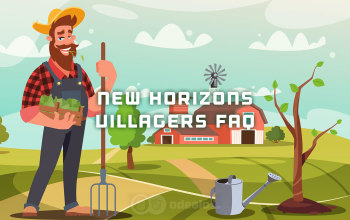
Animal Crossing: New Horizons Villagers FAQ
An in-depth guide on Villagers in Animal Crossing: New HorizonsAnimal Crossing: New Horizons
Villagers FAQ
Introduction
Villager system is one of the main features of all games in the Animal Crossing series. During gameplay, the player is able to invite, interact with, and befriend his villagers who, in turn, will make his playthrough more varied, enjoyable, and funny. Unlike the player, who is always portrayed as a Human, all villagers appear as anthropomorphic animals; they keep an upright posture, wear clothes, speak, and display a plethora of human emotions. Moreover, they all have distinct personalities and interests. Each of the Animal Crossing iterations has added something to the villager system, both mechanic and content-wise, which results in quite a lot of information that has to be ingested by a new player. This is why we have decided to gather the most commonly appearing villagers-related questions and create a comprehensive FAQ out of them.
Note: This guide is by no means complete, so if you have any other questions related to the villagers' topic, feel free to ask them in the comments section below.
|
|
Villagers FAQ
Q: How many villagers there are in Animal Crossing: New Horizons? |
|
As of right now, there are 393 different villagers you can invite to your island, but that number is likely to change with future updates. |
Q: How many villager species there are, in Animal Crossing: New Horizons, and what are they? |
|
There are 35 species of villagers; Wolf, Tiger, Squirrel, Sheep, Rhino, Rabbit, Pig, Penguin, Ostrich, Octopus, Monkey, Mice, Lion, Koala, Kangaroo, Horse, Hippo, Hamster, Gorilla, Goat, Frog, Elephant, Eagle, Duck, Dog, Deer, Cub (which are adolescent bears in essence), Cow, Chicken, Cat, Bull, Bird, Bear, Anteater, and Alligator. |
Q: Which villagers are the rarest because I want to invite ones that none of my friends already have? |
|
Judging by the number of villagers that belongs to any given species, the Octopi are the rarest because there are only three of them at the moment (Zucker, Octavian, and Marina). Cow villagers are also quite rare as there are only four of them (Tipper, Patty, Norma, and Naomi). |
Q: Which villagers are the best for my island? |
|
We have a separate guide which addresses that question very thoroughly, you can check it out HERE. If you are not interested in details, here is a short version: from our experience, the best villagers in Animal Crossing: New Horizons are Marshal, Julian, Coco, Merengue, Fauna, Rosie, Audie, Apollo, Bob, and Goldie. |
Q: I’ve heard that my villagers can have different personalities, what are they? |
|
There are 8 villager personalities in total, 4 male and 4 female: Female:
Male:
|
Q: Which villager personalities collide and do not get along with each other very well? |
|
Q: How many villagers can reside on my island at any given time? |
|
There is enough living space for up to 10 villagers on any player-owned island. You will have to provide each of your villagers with proper accommodation, however. |
Q: Who are Starting Villagers and how many of them do I get in New Horizons? |
| Starting Villagers are the first ones to settle on your island when you start a new game. In Animal Crossing: New Horizons, you will always get 2 starting villagers with predetermined personalities; 1 Sisterly female villager and 1 Jock male villager. |
Q: What do Villagers do exactly? |
| Their role varies a bit from one iteration of the game to another. In Animal Crossing: New Horizons, villagers can plant and water flowers, interact with objects (they can use furniture they come across, for example), exercise, perform yoga, gossip with each other and the player, sing, tell stories and jokes or even visit the museum. They can also send you presents and provide you with medicine. Basically, there are in the game to keep you company and make the game more alive and enjoyable. |
Q: When will I be able to invite new Villagers to settle on my Island and how to do that? |
|
After the Nook's Cranny opens and Tom Nook gives you three housing kits. Placing them around the island will create a living space for new Villagers. After that is done, you will have to furnish newly-built houses with three pieces of indoor furniture and three pieces of outdoor furniture. With all that completed, all you need to do is wait for the Villagers to settle in (one new Villager will appear each day). Note: This only applies to the first three new Villagers who will settle on your Island. For all subsequent ones, all you need to do is designate a plot of land on which they can settle on. |
Q: How do I invite more new Villagers to my Island? |
|
Important Note: If you have designated a plot of land for settling, a random new Villager will, sooner or later, buy it and settle there. Luckily, you can turn the odds in your favor by encouraging specific villagers to move in. There are a few ways of inviting new Animal Crossing: New Horizons Villagers to settle on your Island; they include:
|
Q: How do I... "encourage" a Villager to leave my Island? |
|
There are a few ways of doing this (we will not delve into your motivations for throwing someone into the street):
|
Q: How do I become best friends with a Villager in New Horizons? |
|
The presence of the "friendship" mechanic is not immediately apparent in Animal Crossing: New Horizons, but it is there and it is fully functional. It will allow you to befriend your favorite villagers by interacting with them in certain ways. In simple terms, to become best friends with a villager, you have to make them like you as much as possible, which is achieved by:
Your "befriending" progress is indicated by gradually appearing new interaction options, like being able to present a villager with a gift or being able to change their catchphrase. After a villager truly becomes your best friend, you will receive a framed photo, that you can display in your house, from him/her. |
Q: What are the "Villager Quests"? |
| Villagers who like you will often ask you to do specific things, like going on a treasure hunt, catching a specific bug or a fish, making a certain piece of furniture for them, or finding something that they lost and returning it to them. These tasks are what is called "Villager Quests". |
|
|
|
END NOTE If you have any questions, about Animal Crossing: New Horizons Villagers, that still need answering, feel free to leave them in the comments section below. We will be glad to answer them and add them to our FAQ list. We hope that you have found this FAQ useful and informative. If you liked it and want us to make more FAQs like this in the future, please let us know! Also, we will be happy to receive constructive criticism that will help us improve our future work so leave your suggestions in the comments section below. |


